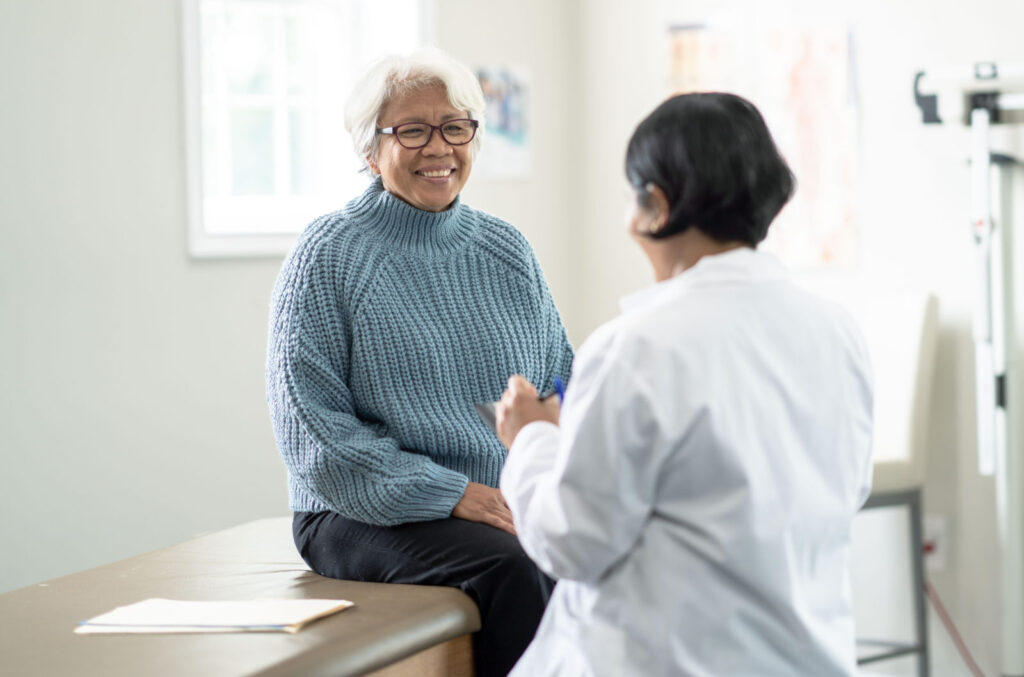
Older adults in America face a slew of health disparities. Health economist Jane Sarasohn-Kahn dives deeper into recent research about older Americans’ health.
By Jane Sarasohn-Kahn, MA, MHSA
After 10 years of extending lifespans and quality of life-years for older adults in America, recent research shows a spike in early deaths and mental health diagnoses, detailed in the 2022 Senior Report from the United Health Foundation (UHF).
The report—part of UHF’s America’s Health Rankings annual study series—identified concerning statistics that illustrate older Americans’ challenges for health and well-being two years since the COVID-19 pandemic disrupted life and healthcare delivery.
Shortened Lives, Growing Mental Health Diagnoses Among Older Adults
For older adults in America, the report calls out the following statistics from the CDC:
- Early deaths increased by 17% in a one-year span between 2019 and 2020
- The rate of drug deaths doubled, increasing from 4.2 to 8.4 deaths per 100,000 adults ages 65 and over between 2008–2010 and 2018–2020
- The percent of people 65 and over diagnosed as obese increased by 16% between 2011 and 2020
- The rate of suicide among people 65 and older grew by 13% between 2009–2011 and 2018–2020
- Diagnoses of depression in adults 65 and older increased by 9% between 2011 and 2020
Health Disparities in the Medicare Advantage Population
Supporting the UHF findings, an April 2022 report from RAND and the Centers for Medicare and Medicaid Services highlighted disparities in healthcare among enrollees in Medicare Advantage (MA) by race, ethnicity and sex. About 4 in 10 people with Medicare in 2021 were in MA plans.
RAND assessed disparities based on patient experience (CAHPS) and 36 clinical care measures (HEDIS), across conditions, medication management and access criteria.
Based on these data sets, RAND identified disparities in clinical care measures finding Black, American Indian/Alaska Native, and Hispanic MA enrollees with many clinical care measures below the national average. Specifically, Black MA members had 14 of 36 clinical care measures below the national average, and Hispanic MA enrollees had 11 of 36 measures below the national average.
Scores for white MA enrollees were similar to the national average on 31 measures and above the national average for five measures.
Long-COVID Symptoms Overlooked in Older Americans
The CDC calculated that as many as 2.5 million older adults in the U.S. might have been dealing with long-COVID, symptoms from the coronavirus that can last weeks, months or years beyond the initial phase of the infection.
“The challenge is that nonspecific symptoms such as fatigue, weakness, pain, confusion, and increased frailty are things we often see in seriously ill older adults,” Dr. Charles Thomas Alexander Semelka, a geriatric specialist at Wake Forest University, told Kaiser Health News. Because of the visible symptoms of fatigue or growing frailty, for example, physicians could assume “that’s just part of aging,” Dr. Semelka noted, causing long-COVID to be overlooked or underestimated in older patients.
Can Digital Health Tech Help Address Older Adults’ Health Disparities?
Health disparities are deeply rooted in a combination of various determinants of health, healthcare payment incentives, and social factors such as system and clinician bias.
But digital health technology may play a role in mitigating some of the risks that lead to health disparities among older people.
USA Today covered the growing portfolio of services to help people age well at home as “Uber for eldercare.”
While it can be tempting to “Uber-ize” digital interventions popular in our daily lives, the point is that well-designed and well-intentioned digital health tools can help address risks of disparities and access to care for older people.
For example, AARP’s latest look at telemedicine found that 3 in 5 people age 50 and over would likely use virtual care in the future. Millions of older patients got acquainted with telemedicine during the COVID-19 pandemic, using Zoom, FaceTime and other platforms to meet with their physicians for chronic care management and urgent care triage.
In the context of health disparities and race, it is important to note that relatively more Black patients age 50 and older would be interested in using telehealth in the future compared with white patients, a data point that can help inform public policy targeted to addressing healthcare access in communities of color.
A May 2022 study published in Health Affairs revealed that Medicare beneficiaries living in disadvantaged neighborhoods increased telemedicine use during the COVID-19 pandemic, following the coverage waivers taking effect. “CMS was, in fact, successful in reaching even people in the most disadvantaged US neighborhoods with its telemedicine coverage waiver, at least among Medicare beneficiaries,” the authors call out.
While this finding was encouraging, the odds of using telemedicine in these neighborhoods declined with increasing age, a factor that should be considered when designing virtual care programs for older, less affluent people.
AARP’s study also found that the pandemic took a toll on older adults’ emotional and mental health. For example, 45% of people 50 and older said they had been bothered by anxiety in the two weeks prior to the survey, and 31% of older adults had feelings of depression or loneliness.
Enter Papa, a company that defines itself as a “curated platform of companionship and support for older adults and families.” Papa and the Papa Pals program collaborate with health plans (such as Medicare, Medicaid, and commercial insurers) and health systems to provide “family on demand,” a companionship benefit for older people and their families. Papa’s research demonstrated that Papa Pals can reduce health plan members’ loneliness by 68%. The ROI on averting loneliness is that lonely people have been shown to utilize inpatient hospitals 60% more than people who do not self-identify as lonely.
That companionship is a strategic lifeline for the social isolation epidemic among older people, either isolated through disability and lack of transportation or through rural geographic constraints—that ZIP code being such a potent contributor (or detractor) to well-being.
The Intertwined Risks of Health Disparities for Older Adults
The UHF 2022 Senior Report included a map of the U.S., illustrating regions of the nation where older adults experience greater levels of risk of social isolation. These tend to be in the southern and south-central U.S., with a similar map of the overall state rankings. Mental and emotional health are highly tied to physical health outcomes.
Thus, addressing one risk factor that underpins health disparities—say, for heart disease—is necessary but not sufficient to dealing holistically with the clinical problem. Beyond heredity and a patient’s genetic endowment, the SDoH risks of cardiovascular disease are many and intertwined: for example, access to healthy food and nutrition choices, physical activity and a neighborhood with active transportation, health literacy for medication management (tied to education and general literacy), and psychosocial stress (part of the risk factor for social and community cohesion).
Identifying Solutions to Healthcare Disparities
Stakeholder organizations in the healthcare ecosystem are increasingly recognizing and incorporating strategies to address health equity in business plans, with public policy lagging behind the private sector’s more nimble ability to act on these challenges—and opportunities. Housing, food and transportation initiatives are among the lowest-hanging fruit tactics companies are taking on. Foundations, too, have long addressed health equity and disparities.
For example, the John A. Hartford Foundation has partnered in the Age-Friendly Health Systems Initiative with the American Hospital Association and the Catholic Health Association to incorporate “4 Ms” into the program: What Matters, a consumer-centered design approach to aligning with peoples’ preferences and personal clinical goals; Medication, for prescription drug safety and management; Mentation, focused on mental health issues such as depression, dementia, and delirium; and Mobility, which assesses the person’s ability to safely get around.
“Healthcare treatment decisions that help older adults achieve what matters most to them—like daily walks without pain, having the energy for gardening, or talking with grandchildren while feeling clearheaded—result in healthier aging,” said Dr. Kedar Mate, MD, President and CEO of IHI (a partner in the program).
The Hartford Foundation approach is just one example of an effort to address health disparities that is integrative across many dimensions and risks for inequitable care and outcomes. Healthcare providers and systems, life science companies, health plans and payers have the opportunity to collaborate on multi-factored solutions with each other as well as community-based organizations that older people trust to bolster their health and wellbeing and reduce disparities.
There is an African proverb from Sierra Leone that says, “Those who respect the elderly pave their own road toward success.” This is the ethos we should embrace when reimagining healthcare for older people. Not only is this a pillar of cultural competency in healthcare, but sooner or later … we will be wearing our elders’ shoes.



About The Author: Jane Sarasohn-Kahn, MA, MHSA
Through the lens of a health economist, Jane defines health broadly, working with organizations at the intersection of consumers, technology, health and healthcare. For over two decades, Jane has advised every industry that touches health including providers, payers, technology, pharmaceutical and life science, consumer goods, food, foundations and public sector.
More posts by Jane Sarasohn-Kahn, MA, MHSA